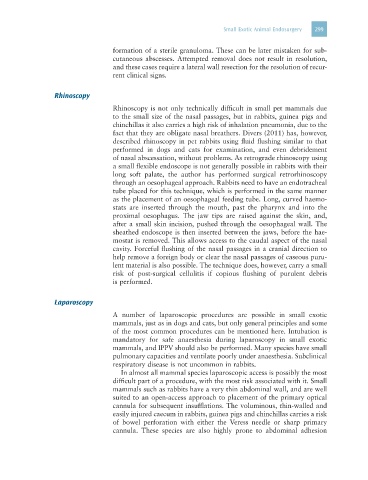Page 311 - Clinical Manual of Small Animal Endosurgery
P. 311
Small Exotic Animal Endosurgery 299
formation of a sterile granuloma. These can be later mistaken for sub-
cutaneous abscesses. Attempted removal does not result in resolution,
and these cases require a lateral wall resection for the resolution of recur-
rent clinical signs.
Rhinoscopy
Rhinoscopy is not only technically difficult in small pet mammals due
to the small size of the nasal passages, but in rabbits, guinea pigs and
chinchillas it also carries a high risk of inhalation pneumonia, due to the
fact that they are obligate nasal breathers. Divers (2011) has, however,
described rhinoscopy in pet rabbits using fluid flushing similar to that
performed in dogs and cats for examination, and even debridement
of nasal abscessation, without problems. As retrograde rhinoscopy using
a small flexible endoscope is not generally possible in rabbits with their
long soft palate, the author has performed surgical retrorhinoscopy
through an oesophageal approach. Rabbits need to have an endotracheal
tube placed for this technique, which is performed in the same manner
as the placement of an oesophageal feeding tube. Long, curved haemo-
stats are inserted through the mouth, past the pharynx and into the
proximal oesophagus. The jaw tips are raised against the skin, and,
after a small skin incision, pushed through the oesophageal wall. The
sheathed endoscope is then inserted between the jaws, before the hae-
mostat is removed. This allows access to the caudal aspect of the nasal
cavity. Forceful flushing of the nasal passages in a cranial direction to
help remove a foreign body or clear the nasal passages of caseous puru-
lent material is also possible. The technique does, however, carry a small
risk of post-surgical cellulitis if copious flushing of purulent debris
is performed.
Laparoscopy
A number of laparoscopic procedures are possible in small exotic
mammals, just as in dogs and cats, but only general principles and some
of the most common procedures can be mentioned here. Intubation is
mandatory for safe anaesthesia during laparoscopy in small exotic
mammals, and IPPV should also be performed. Many species have small
pulmonary capacities and ventilate poorly under anaesthesia. Subclinical
respiratory disease is not uncommon in rabbits.
In almost all mammal species laparoscopic access is possibly the most
difficult part of a procedure, with the most risk associated with it. Small
mammals such as rabbits have a very thin abdominal wall, and are well
suited to an open-access approach to placement of the primary optical
cannula for subsequent insufflations. The voluminous, thin-walled and
easily injured caecum in rabbits, guinea pigs and chinchillas carries a risk
of bowel perforation with either the Veress needle or sharp primary
cannula. These species are also highly prone to abdominal adhesion

